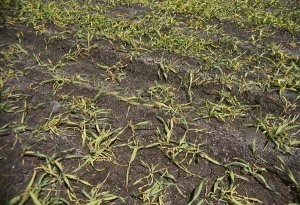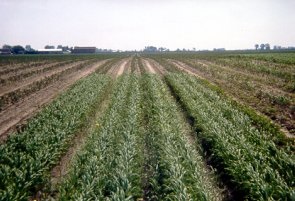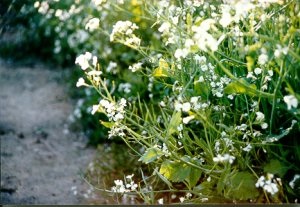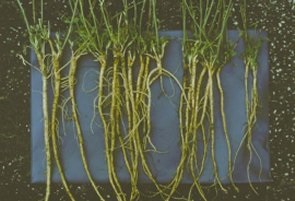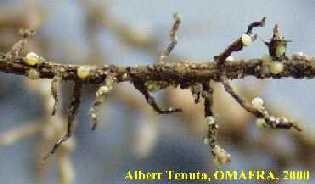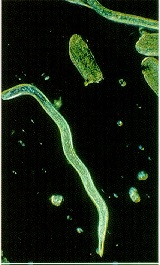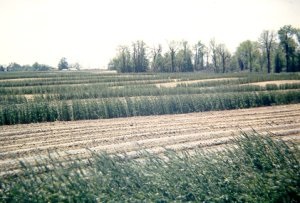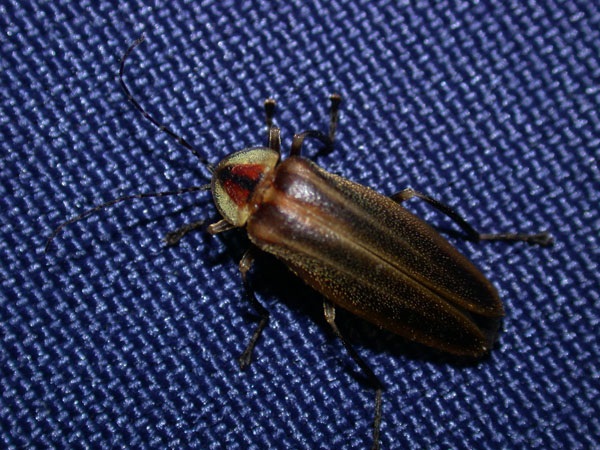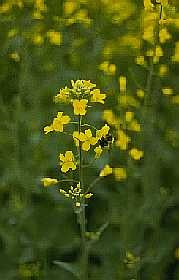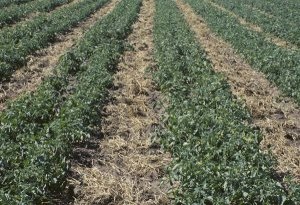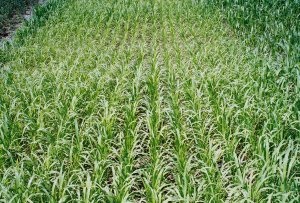Cover crops: adaptation and use of cover crops
Learn about the important role cover crops play in maintaining soil quality and productivity.
Introduction
Cover crops play an important role in maintaining soil quality and productivity on Ontario farms. Usually we think of cover crops in terms of reducing soil erosion and adding organic matter to the soil — but they can do much more:
Cover crop functions
Reduce soil erosion
Cover crops can do exactly what their name implies; cover the soil. A cover crop such as rye is commonly used to cover and protect the soil surface from wind and water erosion. The top growth covers the soil surface while the roots bind and stabilize the soil particles.Cover crops may be planted over a whole field for erosion protection, or they may be selectively planted in the most erosion prone areas. – such as sandy knolls for wind erosion, water runs or low areas for water erosion.
Good stand establishment and vigorous growth is important to ensure adequate erosion protection. For the most erosion prone areas, this can be a real challenge. For example — in a field with high sand knolls often it is difficult to get a good growthy cover crop on the knolls. The lack of growth/stand can be due to a low organic matter, pH problems, droughtiness etc. This is also the most erosion prone area and may "blow out" over winter if there is little snow cover due to the lack of cover crop protection. It's essential to plant into moisture.
Add organic matter
Cover crops do add organic matter but the amount really varies depending upon the cover crop species and the conditions under which it is grown. The table below gives dry matter levels (above ground residues only) for some common cover crops established in late summer and early fall. The numbers were collected from cover crop plots in Southwestern Ontario.
| Common cover crops | Dry matter produced (kg/ha) |
|---|---|
| Red clover (plowdown) | 2,700–4,500 |
| Oats | 1,000–5,500 |
| Rye | 1,000–4,000 |
| Oilseed radish | 2,000–7,500 |
These may not show as great an organic matter return as some of the cover crop work from the United States, however it is important to consider climatic differences and how the cover crop is incorporated into the crop rotation.
It would take 20 years to build the organic matter 1% (provided that the soil was never worked to speed up decomposition). But don't despair! It may be a slow process, but it's possible to improve over time. Cover crops and manure certainly help.
Work to either improve or at least maintain organic matter. If you do nothing and continue cropping, your organic matter levels will continue to drop.
Building organic matter is a slow process, maintaining it is probably more realistic. Current research suggests that only 20 % of any residue returned to the soil will make it to the organic matter pool. The remaining 80 % becomes part of living organisms, is released as gases during digestion or has not become part of the organic matter flow.
For example: Soil organic matter is measured in the top 15 centimeters or to plow depth. This "hectare/furrow slice" weighs about 2,000,000 kilograms. Thus, 1% organic matter equates to 20,000 kilograms.
In a best case scenario, only 20% of any residue returned to the soil will make it to the organic matter pool. The remaining 80% becomes part of living organisms, is released as gases during digestion, or has not become part of the organic matter flow.
It takes 5 kilograms of crop residues to make 1 kilogram of organic matter.
20,000 kg O.M. x (5 kg residue ÷ 1 kg O.M.) = 100,000 kg residue (1% O.M. increase)
Thus, it requires 100,000 kilograms of crop residue to raise the soil organic matter 1%. Assuming an average residue return of 5,000 kilograms from the above table:
100,000 kg residue ÷ 5,000 kg residue/year = 20 years
The addition of fresh organic material is important in stimulating soil biological activity. Cover crops also help to maintain soil life by shading the soil and moderating soil conditions.
Reduce nutrient losses
Some cover crops fix nitrogen but many more require nitrogen to grow. Grass cover crops like rye and Brassicas like oilseed radish are excellent scavengers of nitrogen left behind by the main crop or from manure applications.
Cover crops that take up nitrogen can help to reduce nitrogen losses due to leaching. This reduces the potential for the contamination of shallow aquifers by nitrates.
Nitrogen "catch crops" are used to prevent winter injury to perennial crops such as grapes and fruit trees. Cover crops such as rye seeded in late summer and early fall take up the excess nitrogen — preventing the perennial crop from continuing vegetative growth and encouraging hardening off for the winter.
When the cover crop is killed the nutrients held in the plant tissues are returned to the soil and can be used by the following crop.
Work done by in Ontario Dr. Eric Beauchamp on cover crops and nitrogen release suggests that growers should be aware of the nitrogen release potential from their cover crop species. Oilseed radish is an excellent nitrogen scavenger but as it winterkills the tissues start to break down before the spring crop is in place and needing nitrogen. Some nitrogen losses can occur. In contrast, ryegrass tends to hold onto the nitrogen more tightly, with the main release occurring in early to mid summer. Clovers tend to release nitrogen in early summer also. Timing of the nitrogen release may be important if growing crops like small grains, tomatoes and other fruiting vegetables.
Improve soil fertility
Legume cover crops can fix nitrogen for a subsequent crop. Organic growers often include this type of cover crop in order to produce nitrogen for the rest of the crop rotation. Some cover crop species are credited with making more phosphorous available to other crops through the action of the roots. Deep-rooted cover crops can bring nutrients up from deep in the soil profile
Reduce pest populations
Some cover crop species maybe a non-host for a pest or may release materials that are toxic to the targeted pest. For example many common cover crops have been rated for their ability to support root lesion and other nematode populations (see Chart) Cover crops like marigolds and pearl millet do not support or do not allow the nematode to reproduce. Other cover crops like some mustards, particularly those with high glucosinilate and euricic acid levels in the plant tissue can create a "natural fumigant" through the chemical breakdown of the these materials. The amount of green plant material that must be tilled into the soil for this to be effective, is often difficult to achieve under field conditions. Weeds are often alternate hosts for the nematodes. Good cover crop establishment, adequate plant stand and excellent weed control within the cover crop is critical for these methods of nematode reduction/suppression to be effective.
Soybean cyst nematode (SCN) causes the most economically important disease of soybeans in North America. The estimated annual loss in southwestern Ontario is $5 to 10 million. Research done at Harrow (AAFC) has indicated that rotational crops of red clover, Japanese millet, field corn and resistant soybeans have the greatest effect in reducing populations of SCN. Perennial ryegrass, alfalfa, sorghum, and hairy vetch are not as effective in reducing SCN populations. Unfortunately, most of these nematode reducing crops are not profitable enough to fit into most growers' rotations.
Further research is ongoing to develop crop rotations that are cost-effective and able to reduce the SCN pressure. Currently winter wheat (a non-host) with an underseeded legume crop (stimulates the SCN to hatch) is the favoured approach. Legumes for wheat underseeding that are most suited to encourage hatching are being evaluated. A similar approach is planned for underseeding in corn.
Research work in Ontario on rye cover crops used as wind strips and in no-till systems for processing tomato production has found that rye will act as a physical barrier to pests. Dr. David Hunt and Dr. Al Hamill of AAFC in Harrow have documented that rye cover crops interfere with Colorado potato beetle movement early in the spring, during tomato transplanting.
Cover crops can be helpful in controlling or suppressing pests, however the opposite is true. It is important to consider pest relations when choosing a cover crop.
Cover crops can also provide habitat for bees and beneficial organisms. Predatory mites, ladybug beetles and other beneficial insects benefit from the cover and protection that a cover crop provides.
Reduce compaction and improve soil structure
Cover crops can help to reduce compaction and improve soil structure. The addition of the plant top and, especially root matter, helps to improve water infiltration and holding ability. It can also decrease soil bulk density. Deep rooted cover crops can help to decrease the impact of soil compaction. If deep tillage is used to combat compaction, the seeding of a cover crop can help to stabilize the cracks and fissures that were created in the soil profile by the deep tillage. Growing cover crops and working in the residues improves soil structure.
In the early '90's a tomato rotation and cover crop project in southwestern Ontario (ref) found that there was a sizable benefit to the return of almost any crop material to the soil. This was particularly true of one site with an extremely low organic matter fine sandy loam. Soil crusting and lack of aeration was typically a problem unless residues were incorporated. One of the best yielding rotation was an intensive vegetable and seed corn rotation that allowed the growth and incorporation of a sizable amount of cover crop residues.
Water management
Cover crops can be grown and the residues used to mulch the crop and help to reduce moisture loss.
In contrast, some growers use cover crops such as rye as a way to reduce soil moisture in early spring. The crop takes up the soil moisture and uses it within the plant. The water is incorporated in the plant tissues or is transpired. Either way the water is removed from the soil.
Caution: this use of cover crops requires very good management and understanding of plant growth habits. Under warm wet conditions some cover crops can become very difficult to control either with tillage or chemically. Also under dry spring conditions the cover crop should be controlled earlier to prevent excessive moisture loss which may interfere with crop establishment and growth.
Emergency forage
Under adverse conditions and a shortage of forage due to drought or winterkill, some cover crop species can make quite acceptable hay or pasture.
Footnotes
- footnote[1] Back to paragraph Dry matter production can vary greatly due to a number of production factors.
